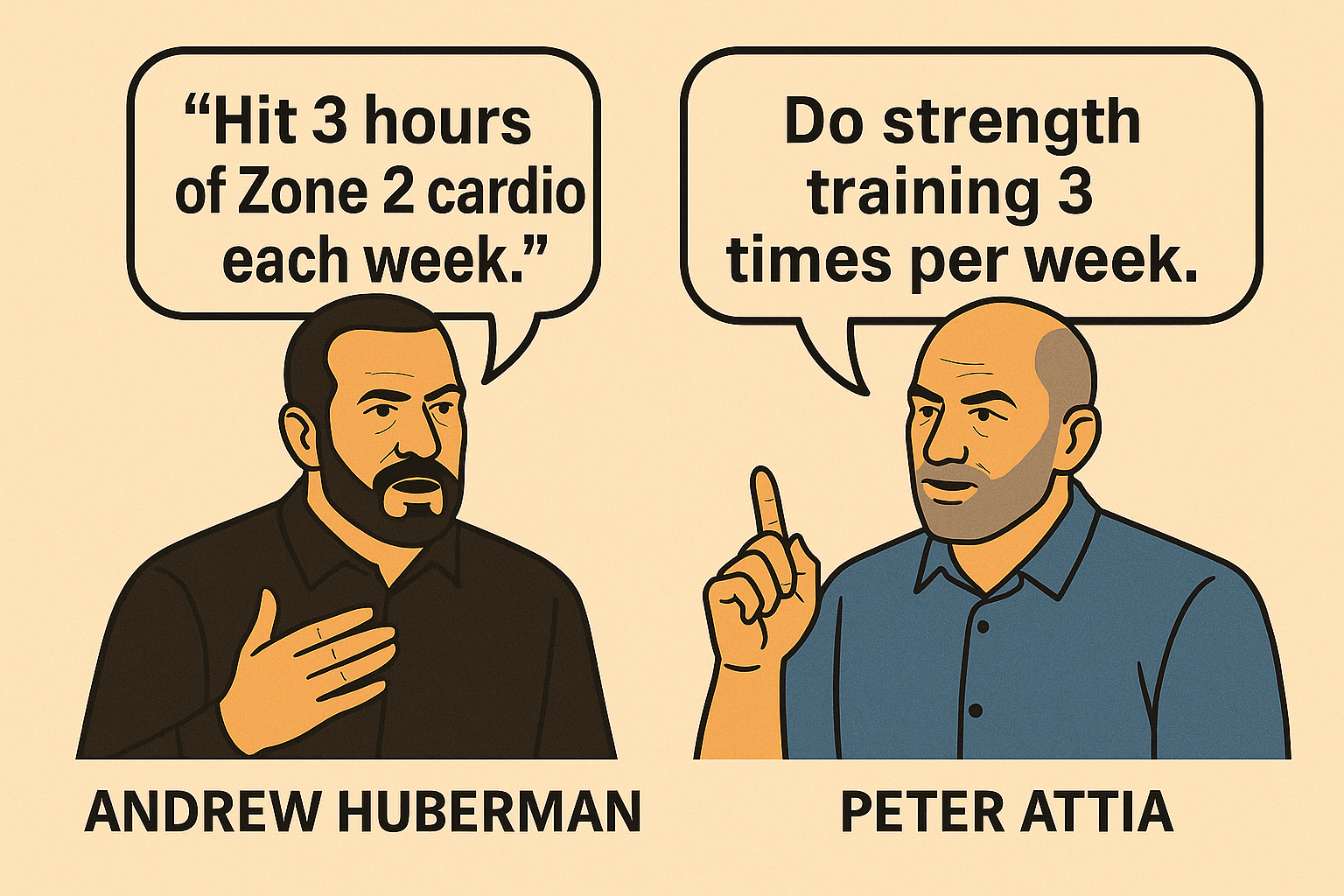
Best Exercises for Longevity for Men over 40 | Huberman & Attia Approved
- Why Exercise Is the Best Longevity Tool for Men Over 40
- How Your Body Changes After 40:
- The 4 Pillars of the Longevity Exercises
- 1. Strength
- 2. Stability
- 3. Zone 2 Cardio
- 4. VO₂ Max / Zone 5
- Weekly Longevity Workout Plan for Men Over 40
- 1. Build your week
- 2. Progress conservatively
- 3. Layer daily movement
- 4. Track simple metrics
- Essential Fitness Priorities for Men Over 40
- Preserve Your Muscle
- Extend Recovery Windows
- Protect Your Joints
- Cardio for Longevity
- Consistency over Intensity
- FAQs about the Best Longevity Workouts for Men Over 40
- Final Takeaways for Longevity Exercises for men over 40
Why Exercise Is the Best Longevity Tool for Men Over 40
Over 70% of adults over 40 aren’t strength training—yet men begin losing 3–5% of lean muscle mass every decade after 30, with that loss accelerating sharply in their 50s. Fitness is no longer “nice to have.” It’s about staying functional, preventing disease, and protecting your brain. It’s protective medicine.
Neuroscientist Dr. Andrew Huberman calls a weekly combination of strength training, 3–4 hours of Zone 2 cardio, and one VO₂-max session “the closest thing to a super-pill” for your brain and body health. And science agrees: this formula boosts mitochondria, hormones, metabolism, and even mental clarity.
In this guide, we break down the best exercises for longevity for men over 40, combining Huberman’s protocol with longevity physician Dr. Peter Attia’s clinical targets. If you’re looking for a science-backed, time-efficient plan to halt muscle loss, boost energy, and extend your healthspan, you’re in the right place—let’s rebuild that reserve.
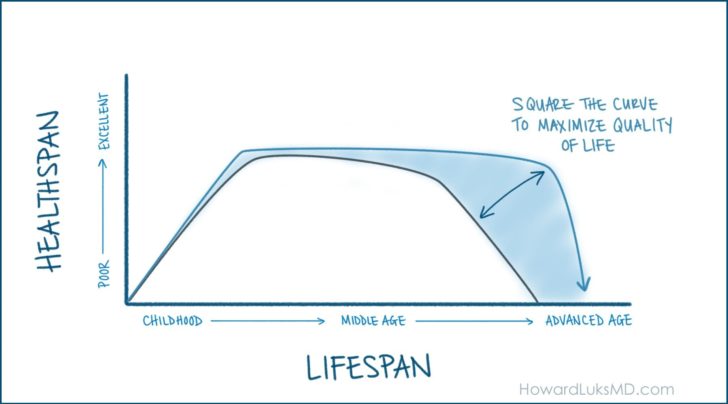
Dr. Howard J. Luks’ Longevity Simplified graph shows health peaking in mid‑life before plunging sharply without action. Consistent strength, stability, and aerobic training can extend healthspan and “square the curve,” keeping function high almost to life’s end.
How Your Body Changes After 40:
Accelerated muscle & bone loss
- After 40, you naturally lose about 3–5 % of muscle every decade and bone density begins to decline in parallel. Without regular strength training and adequate protein, this acceleration leads to sarcopenia and higher fracture risk well before old age.
Declining aerobic capacity
- As we age, our heart and lungs can’t pump oxygen quite as efficiently. So by your late forties or early fifties, you might notice you’re breathing harder after climbing a single flight of stairs or running for just a minute. That “huff‑and‑puff” feeling is your VO₂ max drifting down as the years stack up. Staying active now can slow the slide and even push your VO₂ max back up.
Hormonal & metabolic shifts
- You may see stubborn belly fat, carb crashes, slower recovery—signs testosterone, growth hormone and insulin sensitivity are sliding. Strength work, Zone 2 cardio, protein‑rich meals and solid sleep can flip those hormones back up, burning fuel instead of stockpiling.
Brain & mental‑health impact
- You might notice you take longer to recall names or juggle tasks—that’s because processing speed and working memory slow, gray matter volume shrinks ~0.5% per year, and dopamine receptors decline. Regular aerobic exercise promotes neurogenesis and helps preserve cognitive function.
The 4 Pillars of the Longevity Exercises
Both Andrew Huberman and Peter Attia treat exercise as a four‑part prescription for lifelong health: strength, stability, Zone 2 aerobic work, and VO₂ max/Zone 5 peaks. Together they sketch a weekly template of three to five strength sessions, daily stability drills, three to four hours of Zone 2, and one high‑intensity interval block—all scalable for men 40‑plus who want to extend both health‑span and functional capacity.
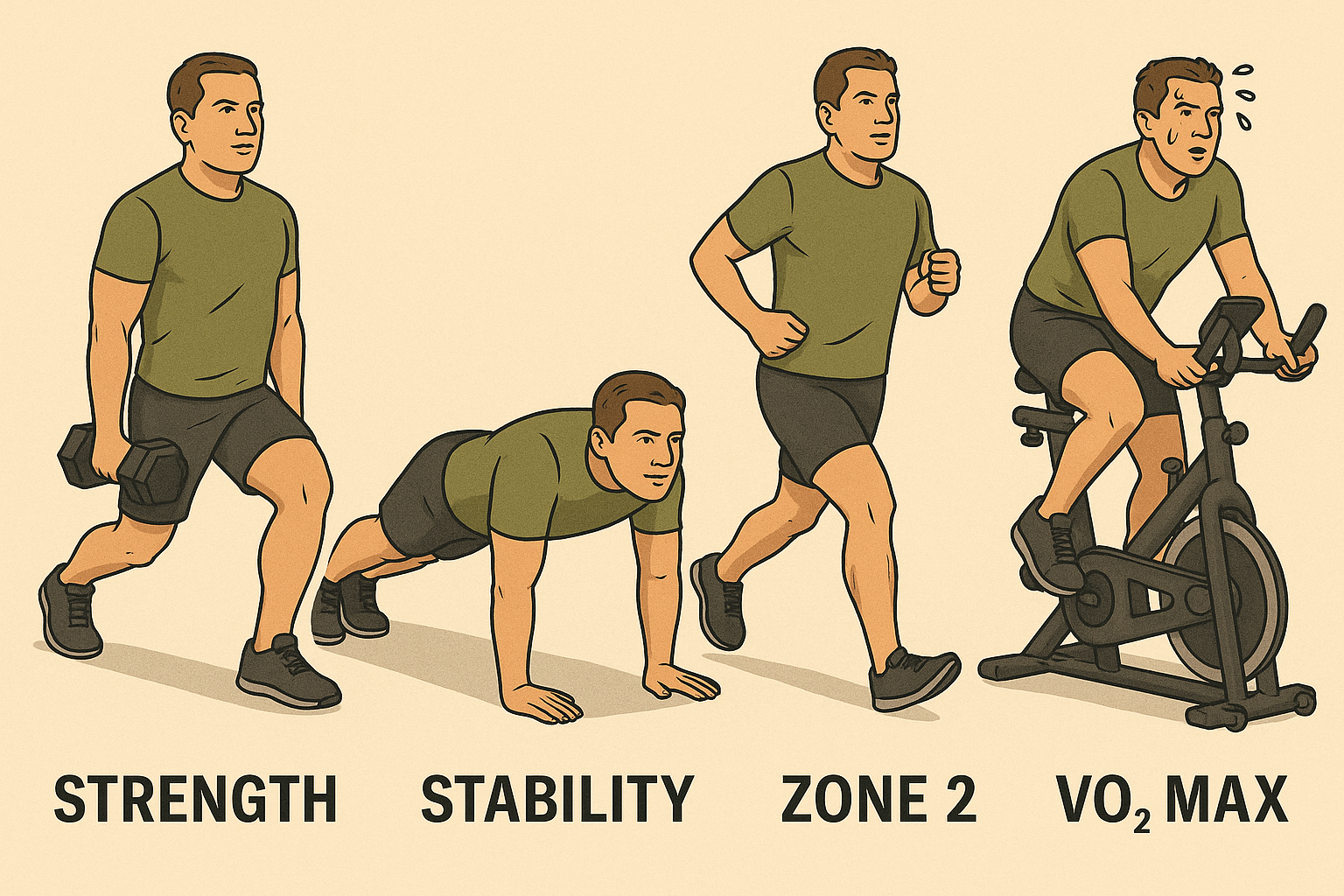
1. Strength
- What it is: Moving heavy resistance—barbells, dumbbells, kettlebells, resistance band, body‑weight—in low‑to‑moderate rep ranges (5–10 reps) to overload muscles and bones.
- Why it matters: Counters the 3‑5 % per‑decade muscle loss after 30, preserves metabolic rate, strengthens bones, and builds the “reserve” you’ll need for late‑life independence.
- How it feels: Hard but controlled; muscles burn on the last 2 reps, breathing deep but able to speak in short phrases between sets.
- Exercises: Barbell deadlift, goblet squat, dumbbell bench press, pull-ups, lunges.
2. Stability
- What it is: Drills that teach joints and core to resist or precisely control motion—balance, anti‑rotation, and unilateral work.
- Why it matters: Reduces fall and injury risk, improves movement quality, and lets you safely load heavier strength and power work.
- How it feels: Low load, high concentration; muscles shake slightly as you steady yourself, heart rate barely rises.
- Exercises: Dead‑bug, bird‑dog, single‑leg Romanian deadlift, kettlebell suitcase carry, side plank with leg lift.
3. Zone 2 Cardio
- What it is: Steady‑state aerobic work at 65‑75 % of max heart rate (you can talk but not sing).
- Why it matters: Builds mitochondrial density, improves insulin sensitivity, forms the aerobic “engine” that supports recovery and longer life span.
- How it feels: Comfortably warm; breathing deeper than at rest but still in full control—conversation in short sentences is easy.
- Exercises: Incline treadmill walk, easy road cycling, conversational jog, steady rowing.
4. VO₂ Max / Zone 5
- What it is: Short bursts ( 4 min or less) at 90–95 % of max heart rate that push your oxygen‑uptake ceiling.
- Why it matters: VO₂ max is the strongest single cardiorespiratory predictor of longevity; raising it even modestly slashes mortality risk.
- How it feels: Breathless, legs burning; speech limited to single words. Full recovery needed between efforts.
- Exercises: 4-minute (or less) efforts at 90–95% of your max heart rate with 4-minute easy recoveries, repeat 4 times
See FAQ below for more information about heart rate zones
Weekly Longevity Workout Plan for Men Over 40
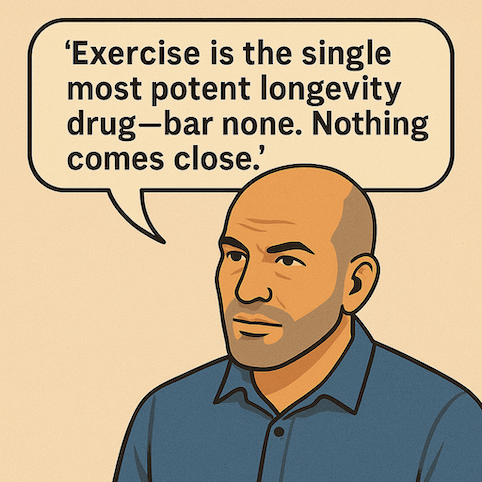
1. Build your week
| Pillar | Peter Attia’s Weekly Targets | Andrew Huberman’s Weekly Targets |
|---|---|---|
| Strength | 3–5 full-body sessions; compound lifts + loaded carries | 3 sessions of heavy compound lifts, 5–10 reps at ≥ 70 % 1 RM; progress ≤ 5 % per week |
| Stability | Daily micro-drills; one 60-min focused session | 5-min stability inserts every workout |
| Zone 2 Cardio | ≥ 3–4 h/week (4 × 45–60 min) at 65–75 % HR max | 150–200 min/week (3–4 × 30–45 min) of easy, conversational cardio |
| VO₂ max / Zone 5 | 1–2 high-intensity bouts | 1 quality 4 × 4 session at 90–95 % HR max each week |
Day 1. Monday – Upper Body Strength
- 10 minutes warm-up and stability: Plank, Side Plank, Bird Dog, Bridge (video), Heel Raises (video), Lunge with Heel Raise (video), Single-Leg Balance + Reach (video)
- Floor Press, Push-Up, Overhead Press, Front Raise, Dumbbell Curl; Chin-Up, Triceps Dip, Skull Crusher, Pull-Up, Face Pull, Shrug, Reverse Fly
- Video - calisthenics upper body, dumbbell upper body
- 5 minutes cool down stretches
Day 2. Tuesday – Zone 2
- 10 minutes warm-up and stability
- Zone 2: easy jog, steady cycling, incline treadmill walk, elliptical machine, swim, or row
- 5 minutes cool down stretches
Day 3. Wednesday – Lower Body Strength
- 10 minutes warm-up and stability
- Barbell Squat, Forward Lunge, Romanian Deadlift, Hamstring Curl, Glute Bridge, Standing Calf Raise, Sumo Squat, Side-Lying Leg Raise, Back Extension, Deadlift, Plank,
- Video - calisthenics lower body, dumbbell lower body
- 5 minutes cool down stretches
Day 4. Thursday – Zone 2
- 10 minutes warm-up and stability
- Zone 2 : easy jog, steady cycling, incline treadmill walk, elliptical machine, swim, or row
- 5 minutes cool down stretches
Day 5. Friday – Full Body Strength
- 10 minutes warm-up and stability
- Barbell Squat, Goblet Squat, Deadlift, Romanian Deadlift, Bench Press, Overhead Press, Pull-Up, Bent-Over Row, Farmer Carry, Suitcase Carry, Russian Twist, Single-Leg Deadlift
- Video - calisthenics full body, dumbbell full body
- 5 minutes cool down stretches
Day 6. Saturday – VO₂ max
- 10 minutes warm-up and stability
- 4-minute (or less) efforts at 90–95% of your max heart rate with 4-minute easy recoveries, repeat 4 times: hard run, indoor bike, uphill sprints, or row
- 5 minutes cool down stretches
Day 7. Sunday – Zone 2 or Active Recovery
- Gentle Movement: 30–45 min of low-intensity Zone 1–2 work (easy walk, spin, swim) or yoga to boost blood flow and clear metabolites.
2. Progress conservatively
- Both agree on micro‑progression—add time or load, not both, and cap weekly jumps at ~5 %.
- If you’re new to exercise or coming back after a long break, begin with short (10-20 min), gentle sessions and steadily increase duration and intensity over time.
- If you’ve never run before, start by building a brisk‐walking habit to avoid injury: aim for 20–30 minutes at a pace that raises your heart rate, three to four times a week. After two weeks, try run–walk intervals (for example, 30 seconds of easy jogging followed by 90 seconds of walking), then gradually lengthen the jog and shorten the walk. Over the next two to three months, you’ll smoothly transition into full 30–45 minute Zone 2 jogs
3. Layer daily movement
- Andrew Huberman frequently emphasizes the benefits of taking a short walk after meals—known as a post-meal stroll. It’s a simple practice involving a leisurely 10 to 30-minute walk, ideally within about half an hour of finishing your meal.
4. Track simple metrics
- VO₂ max estimate each quarter and grip strength (dynamometer).
- Stability: time a single‑leg stand and 1‑min farmer carry at 50 % BW.
- Average pace/speed (minutes per km/mile)
Essential Fitness Priorities for Men Over 40
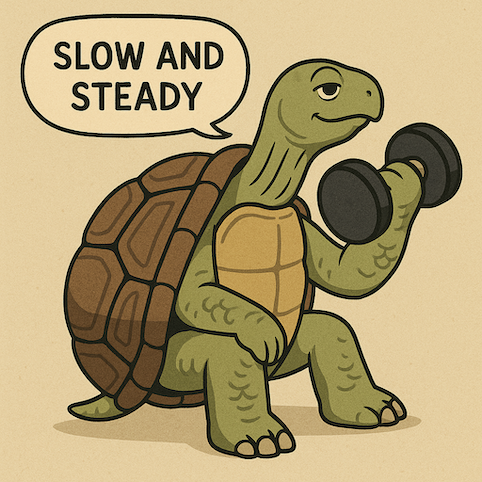
Preserve Your Muscle
-
Muscle loss accelerates mid-life, weakening bones and metabolism. Peter Attia advices to use compound lifts plus loaded carries tied to your “Centenarian Decathlon” goals. They are a list of everyday movements you want to be able to do at 100 such as:
- Pick up your grandkid (set a goal for a 30–40 lb deadlift)
- Walk a mile without getting tired (zone 2 cardio for 30–45 min)
- Carry two bags of groceries (farmer carry 50% bodyweight for 1 min)
- Get up from the floor without using your hands (mobility + leg strength)
Extend Recovery Windows
- Inflammation lingers and hormone-driven repair slows after 40. Schedule 48 h between heavy sessions, deload every 4–6 weeks, and hit 7–9 h of sleep nightly.
- A “deload” every 4–6 weeks means you deliberately dial back your training volume or intensity for a week—think 30 % lighter loads or swapping heavy lifts for mobility and stability work. It gives your muscles, joints, and nervous system a chance to fully recover, so you come back stronger and avoid overuse injuries.
Protect Your Joints
- Connective tissues stiffen and cartilage wears with age. Andrew Huberman advises protecting your joints by prioritizing proper warm-ups, using controlled and deliberate movements with good form, and training through a full, pain-free range of motion.
- He emphasizes not chasing soreness, allowing for adequate recovery, and listening to your body to avoid overuse. Huberman also supports joint health through high-quality sleep, a nutrient-rich diet, and supplements like omega-3s and collagen to support connective tissue.
Cardio for Longevity
- Peter Attia ties cardio—especially zone 2 training—directly to longevity because it improves mitochondrial function, insulin sensitivity, and cardiovascular efficiency, all of which decline with age.
Consistency over Intensity
- Skipping workouts leads to faster declines in strength, muscle, and energy, which is why it’s essential to build a routine you can sustain week after week.
- Peter Attia emphasizes treating fitness as a lifelong habit, built on steady training, sufficient protein intake, and consistent recovery. Andrew Huberman echoes this with his “tortoise over hare” mindset, encouraging small weekly progressions rather than big leaps, warning that increasing weight or distance by more than 5% per week significantly raises the risk of injury.
FAQs about the Best Longevity Workouts for Men Over 40
- What are Heart-Rate Zones?
-
Zone 1
- Effort: Very light (50–60% of your max heart rate)
- Feels like: You can chat easily and breathe through your nose
- What it’s good for: Recovery, gentle movement
- Exercises: Easy walk, slow spin, gentle yoga
-
Zone 2
- Effort: Light to moderate (65–75% of your max heart rate)
- Feels like: You can talk in short sentences, but singing feels hard
- What it’s good for: Heart health, fat burning, endurance
- Exercises: Brisk walk, steady bike ride, conversational jog
-
Zone 3
- Effort: Moderate to hard (75–85% of your max heart rate)
- Feels like: You can say a few words, but it’s getting tough
- What it’s good for: Building stamina and aerobic power
- Exercises: Tempo run, long uphill ride, steady rowing
-
Zone 4
- Effort: Hard (85–90% of your max heart rate)
- Feels like: You can only say one or two words at a time
- What it’s good for: Speed and lactate threshold
- Exercises: 10‑min tempo intervals, mile repeats, hard spin classes
-
Zone 5 (VO₂ Max)
- Effort: Very hard (90–95% of your max heart rate)
- Feels like: You’re breathless and talking is nearly impossible
- What it’s good for: Boosting top-end performance and oxygen capacity
- Exercises: 30‑sec hill sprints, 4×4‑min hard intervals, all-out rowing bursts
2. How can I measure my heart rate while working out?
- Chest‑strap heart rate monitor (most accurate): Wet the sensor pads, strap it snugly under your pecs, pair to your phone, smartwatch, or cardio machine, and watch real‑time bpm on the display.
- Smartwatch or optical wrist-based heart rate monitor: Wear the watch, tightened enough that it won’t slide. Check the workout screen for live heart‑rate and training‑zone readouts.
- Built‑in cardio‑machine grips: Lightly hold the metal handles on treadmills, bikes, or rowers for a quick spot‑check—handy but less reliable than a strap.
3. How often should I work out for longevity?
- 2–4 days of resistance training
- 150–300 minutes/week of moderate cardio (like walking, cycling)
- Daily movement, even low intensity (walking, stretching, etc.)
4. How do I avoid joint pain when lifting heavier?
- Warm up 10 minutes, prioritize form, add stability work (carries, planks), and limit weekly load jumps to ≤ 5 %.
5. Is it too late to build muscle after 40 or 50?
- Not at all. You can build strength and lean mass well into your 60s+ with the right plan, especially if you’re consistent and recovery-focused.
6. Should I change how I eat for longevity fitness?
- Yes, prioritize high protein (to preserve muscle), anti-inflammatory foods (greens, omega-3s, cruciferous veggies), fewer processed carbs and added sugars, and hydration and fiber for digestion
7. Which biomarkers should I track for fitness progress?
- Grip strength, VO₂ max (or a 1‑mile walk HR), waist circumference, resting heart rate, and annual labs for apoB / fasting glucose, testosterone levels, inflammation markers (like CRP), liver and kidney function, insulin sensitivity,
8. How important is sleep and recovery for longevity?
- Arguably more important than training. Without recovery, you can’t grow or repair tissue, regulate hormones, or detox effectively.
9. What are the best supplements for fitness and longevity?
- The most evidence-backed include: creatine, vitamin D3 + K2, omega-3 (fish oil), magnesium glycinate, collagen or protein supplements
Final Takeaways for Longevity Exercises for men over 40
Huberman: If you do nothing else for longevity, get three hours of Zone 2 a week and hit heavy compound lifts at least twice—that alone moves the needle more than any pill on the planet.
By the time you hit 40, the natural decline in muscle, bone, and aerobic capacity begins to accelerate—but every one of those curves is trainable. The best exercises for longevity for men over 40 aren’t extreme—they’re consistent, science-backed, and focused on what matters most: preserving your strength, stamina, and brain health for decades to come.
Following the weekly targets laid out by Huberman and Attia—strength training, Zone 2 cardio, VO₂ max intervals, and stability work—can dramatically reduce your risk of disease, extend your healthspan, and help you stay fully functional well into your 70s, 80s, and beyond.
And remember: any workout beats none. Even one strength session a week puts you ahead of 70% of men over 40 who never train. Progress slowly. Track your gains. Build your reserve. As Attia reminds us, fitness should be a lifelong habit—and it takes about 21 days to lock in any new routine. Start small and build up.
ManSpan Newsletter
Sign up to our newsletter for more longevity tips
no spam • unsubscribe anytime • no b.s.